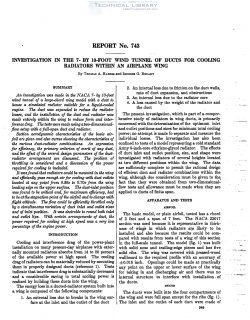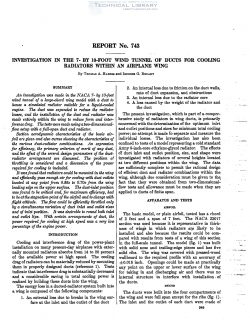naca-report-743

- Version
- 190 Downloads
- 1.82 MB File Size
- 1 File Count
- August 30, 2016 Create Date
- August 30, 2016 Last Updated
National Advisory Committee for Aeronautics, Report - Investigation in the 7x10 Foot Wind Tunnel of Ducts for Cooling Radiators within an Airplane Wing

An investigation was made in the NAC’A 7- by 10-foot
wind tunnel of a large-chord wing model with a duct to
house a simulated radiator suitable for a liquid-cooled
engine. The duct was expanded to reduce the radiator
losses, and the installation of the duct and radiator'was
made entirely within the wi-ng to reduce form and inter-
ference drag. The tests were made using a two-dimensional-
flow setup with afull-span duct a-nd radiator.
Section aerodynamic characteristics of the basic air-
foil are gicen and also curses showing the characteristics of
the carious duct-radiator combinations. An expression
for eficiencg, the primary criterion of merit of any duct,
and the eject of the sereral design parameters of the duct-
radiator arrangement are discussed. The problem of
throttling is considered and a discussion of the power
reguired for cooling is included.
It was found that radiators could be mounted in the wing
and e ficie-ntly pass enough air for cooling with duct outlets
located at any point from 0.25;: to 0.70c from the wing
leadi-ng edge on the upper surface. The duct-inlet position
was found to be critical and, for maximum eficiency, had
to he at the stagnation point of the airfoil and to change with
flight attitude. The flaw could be efi‘iciently throttled only
by a simultaneous variation of duct inlet and outlet sizes
and of inlet position. It was desirable to round both inlet
and outlet lips. With certain arrangements of duct, the.
power required for cooling at high speed was a very low
percentage of the engine power.
Cooling and interference drag of the power-plant
installation on many present-day airplanes with exter-
nally mounted radiators absorbs from 14 to 20 percent
of the available power at high speed. The cooling
drag of radiators can be materially reduced by mounting
them in properly designed duct-s (reference 1). Tests
indicate that interference drag is substantially decreased
and a considerable saving in total cooling power is
realizedby building these ducts into the Wing.
| File | Action |
|---|---|
| naca-report-743 Investigation in the 7x10 Foot Wind Tunnel of Ducts for Cooling Radiators within an Airplane Wing.pdf | Download |

Comment On This Post